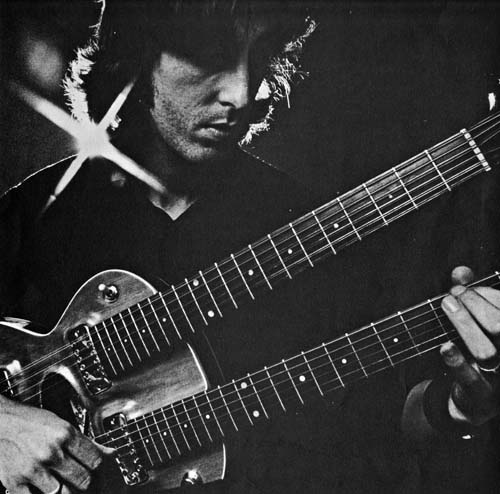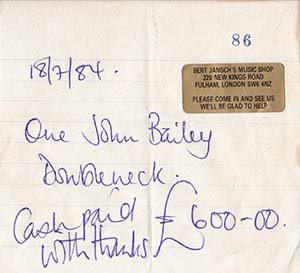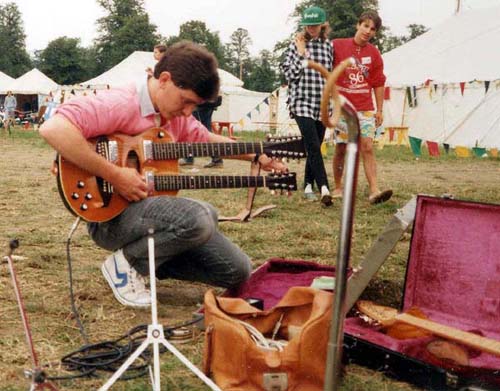 |
|
| Since the death of luthier
John Bailey (1931-2011)
I have noticed an increase in interest in this British maker
amongst players, and particularly in the 6/12 doubleneck guitar which
became the trade mark of guitarist Gordon Giltrap, and which I owned
between 1984 and 1993. So I thought it might be worthwhile gathering together
as much information as I could on this interesting and iconic instrument. I first became aware of Bailey through Giltrap's 6-string acoustic, which I saw and heard on a number of occasions. But my first sight of the doubleneck was in a rather enigmatic clipped shot on the insert of Gordon's Visionary album. I was intrigued what manner of beast this might be:
At that time we lived in London, where Giltrap was due to play a concert to promote the album and his new, entirely instrumental, style. For some forgotten reason I decided to contact him. I had his address having booked him a couple of times for the folk club I'd run in Cambridge, and in his reply he included some promo stickers (which we plastered illegally all over underground stations) and some copies of another photo from the session by Chris Hopper, the definitive Giltrap portarit, in my opinion: |
 |
 |
|
| At last I could see the
Bailey in its entirety, and I fell in love with it. Like all guitarists I
have an eye for the next (unaffordable) Gibson or Martin, but I tend to
settle for sensible, and economical, working tools. The doubleneck is the
only guitar I've ever coveted.
|
|
 |
|
| Fast forward to 1984. I'm driving to a
family gathering in Richmond Park, when I pass the shop Bert Jansch has
opened in Putney. Imagine my surprise to see Gordon's guitar standing up
in the window (with a price tag about three times what I'd ever paid for a
guitar before). I was a bit vacant with the family as I brooded on how I
would regret passing on the opportunity of owning it. Eventually I
calculated that if I sold my MG Roadster (the first decent car I'd had!)
and bought an old Mini, I might get away with it and feed the kids as
well. So the following week I drove down from Essex, played every guitar
in the shop including one of Gordon's Fyldes and Bert's own Yamaha, had
coffee made for me by Jansch himself, and eventually departed with the
Bailey wedged behind the seats of the MG.
Over the following nine years I played it a lot at home, recorded a few tracks, lent it to singer-songwriter Chris Spring for more recording, and did a few gigs with it, including two years at the Greenbelt Festival fringe:
|
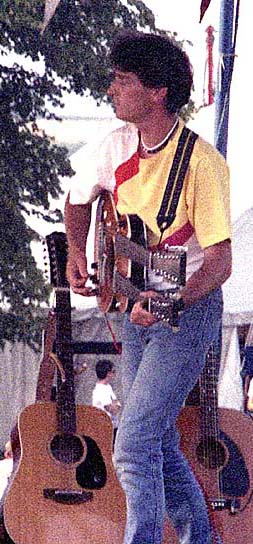 |
| On one occasion (at the Hermit Club, Brentwood) I changed over from my Strat for one song, only to find no sound emerging. An embarrassing few minutes of catcalls ensued until I realised I'd plugged the lead into the stereo jack by mistake. Many years later I saw the same thing happen to Giltrap on an outtake from his Live at Huntingdon Hall video. I was the only person in the world to know what was wrong from the start! | 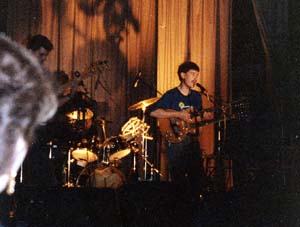 |
 |
|
| In 1993
my church
needed a rebuild for massively growing numbers, and as one of the leaders
I decided to kickstart the project by selling something I valued - the
Bailey was the victim. It worked well. In a few weeks we had pledges to
fund the entire project - and I realised I might have trouble finding an
interested buyer, which would be rather poor. Still, I put an ad in
Guitarist magazine.
One Sunday morning I got a call from a guy in Birmingham asking all kinds of questions and offering me below the asking price. I said I'd get back to him, but when the kids joined me at church they said he'd been on the phone again. On the third call it turned out to be Gordon Giltrap, anxious to re-gather the heritage he'd been forced to part with years before. We met for lunch at the The Griffin and my part in the story ended, other than asking after the Bailey whenever I hear Gordon, and his telling tales about how I charged him extra because it had belonged to a celebrity... |
|
| LINKS: Technical Details History | |
